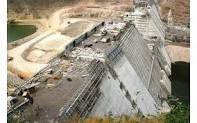 Ghana’s power problem is set to worsen if the water levels at Akosombo do not rise in the coming days.
Ghana’s power problem is set to worsen if the water levels at Akosombo do not rise in the coming days.
Citi News analysis shows that the water level in the dam has been reducing steadily over the past few months and may result in the shutting down of the plant or a massive draw down in output in the next two months if the current trend continues. The dam was designed to operate at a minimum water level of 240 feet. Operating the plant at levels below 240 feet has the potential of damaging the turbines.
The water level recorded Sunday August 17 was 243.73 feet. The water level was at 243.79 feet on Saturday August 16.
A close study of the trend in the depreciation of the water level indicates an average reduction level of 0.06 feet per day. At this rate, the water level will hit the 240.00 feet minimum in approximately 62 days.
CEO of the Volta River Authority, Ing. Kirk Koffi has however dispelled the fears. He told Citi News that even in 2007 when the water level went below 240 feet, the dam did not shut down. He said the worst that could happen in the event of a drastic fall in the water level will be a reduction in production capacity.
Akosombo is Ghana’s biggest power plant and has an installed capacity of 1020 megawatts but it is currently producing just about 775 megawatts, which is 76% of installed capacity declared. A total shut down would leave Ghana with only 538 megawatts of electricity which will be woefully inadequate to power the nation.
The Bui Dam faced a similar situation earlier this year when the water levels fell below the minimum operating level of 168 masl.
The Bui Power Authority said it had been over-drafting at the time, a situation that almost led to damage to the multimillion dollar project.
The Authority said in a statement that: “As a result of the Bui Reservoir reaching the minimum operating level, the rate of power generation at Bui Generating Station has been reduced in order to protect the turbines from potential damage. This is because it is imprudent to operate the generating plant below the minimum operating level of the reservoir (168 masl), as this unduly exposes the turbines to higher risks of damage.”
Ghana requires 500 watts/capita to take a significant step towards industrialization, equivalent to 12500 megawatts. This means Ghana msust invest about $14.5 billion in the power sector to meet it needs in the medium to long term. The Atuabo Gas Project is expected to provide lean gas to increase generation by 540 megawatts. However, the project will not readily make any major impact now because of production issues.
At the time of publication, engineers of the Volta River Authority were in a meeting and are expected to release a statement on the state of Ghana’s power generation in the coming days.





